VIZ Media has teamed up with Rose City Games in order to produce their first video game, The World Next Door! How was their first foray into the world of game publishing? Let’s dig in to find out!
Title: The World Next Door
Platform: Nintendo Switch (Reviewed), PC (Reviewed), MAC
Developer: Rose City Games
Publisher: VIZ Media
Release Date: March 28, 2019
Price: $14.99
The World Next Door is a game that combines many genres into one. It combines elements from a Role-Playing Game, Visual Novel, and a Match 3 Puzzle Game. I’ll get into how all of this affects the combat system and whatnot but first, let’s get a quick synopsis of what the story is about.
The Story
Here in The World Next Door, two worlds: Earth and Emrys, are separated by a great distance in space but feel like neighbors thanks to a dimensional rift that connects them. War broke out over this rift but, eventually, the fighting ended and peace between the two worlds was reached. As a sign of this peace, a portal is opened and, for a limited time, inhabitants of both worlds can visit each other. Thanks to Earth figuring out how to broadcast the internet through the dimensional rift, people from both worlds can text each other.
That’s exactly what happens with a human named Jun and an Emrys named Liza. Jun’s visit there is coming to an end but before she leaves, Liza wants to show her something. She takes Jun to a shrine where she teaches her how to cast magic. After being attacked by a Grievance, a person who got turned into a monster, they escape but by the time they get back to the portal, it’s too late. The portal has closed and now Jun is stuck on Emrys… but there’s one problem. Humans can’t stay on the planet for long periods of time, otherwise, they die. It’s up to Liza and her friends to find a way to get Jun before home before her life runs out.
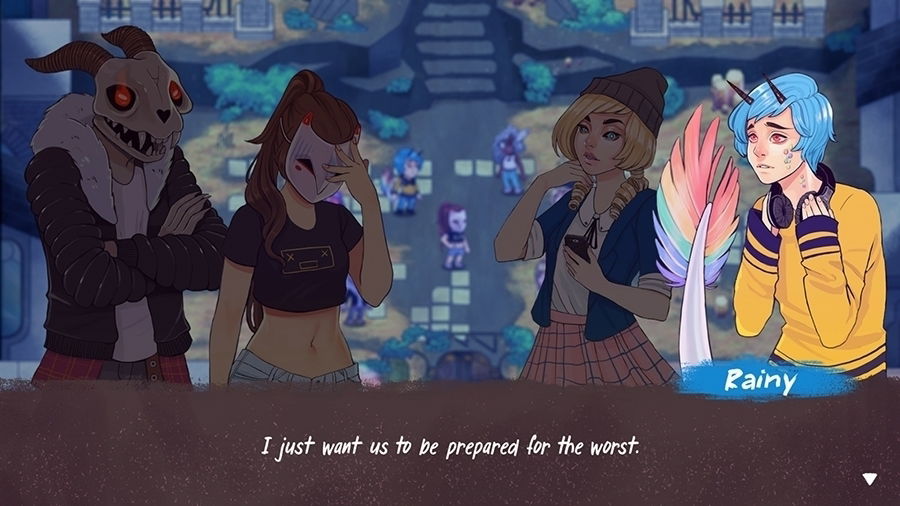
Game Systems – Combat
In your journey to get Jun back home, you discover that you need to visit the four shrines that circle the area. Doing so will empower a sword that Jun found when Liza took her to her first shrine. Somehow, the sword is connected to the portal and they all feel that it may be the key to getting Jun home. Each of the shrines is filled with enemies and a boss that you must overcome and this is done through the games Match 3 Puzzle-like combat system.

There are different colored runes on the ground. If there are three or more next to each other, you can cast a spell matching the corresponding rune. There are six different runes in total: Strike (blue), Ember (orange), Cure (green), Void (purple), Shock (yellow), and Essence (white). Here’s what each of them does:
Strike: This will be an instant attack on the enemy. Nothing really fancy about it. You stand on top of 3 or more blue runes and the closest enemy is dealt instant damage.
Ember: This hurls a fireball at the closest enemy. It is a projectile and does have travel time. It does not hone in on the enemy so you need to make sure they have a good line of sight and aren’t really moving all too much if you want to hit them with this.
Cure: This is exactly what it sounds like. Match 3 or more and heal yourself.
Void: This is a projectile like the Ember spell but its travel time is much slower. It does get the added bonus of dealing big damage on the first hit and really small damage every second the enemy touches the void orb after that. In addition, it slows enemy movement speed.
Shock: This is an electric attack that only affects the panels that were activated. So whichever panels are linked with these yellow runes will become electrified, meaning you will have to lure enemies almost on top of you to hit them with this attack. Doing so, like the void orb, will deal big damage on the first hit and small damage on each subsequent hit. It will also stun enemies in place which means this is a great option to take out enemies who are constantly chasing you.
Essence: This is a special attack from one of your friends. To get white runes to appear you need to match runes during combat of four or more. You then need to align the runes in a certain shape to call on your friends to aid you in battle. Horace, for example, drops a huge fireball on top of an enemy while Rainy will give you a damage shield. Each time you complete a shrine and enter a new one, you will level up, giving you the ability to assign more friends. You can have up to three friends total and can switch them out with ease just by going to the contact menu and picking someone else. Try out all of them and see which ones you like best!
So, I mentioned aligning runes. While runes constantly appear during battle, they may not always appear next to each other. The game allows you to pick up runes and place them next to others. Whichever rune is in the slot you drop one in, will swap places with the rune you took. So if you take an Ember Rune and place it where a Cure Rune is, the two of them will swap places. This way, you can line up a huge amount of runes to deal even bigger damage.
There’s also a system in place where if you have runes lined up next to a different set of runes that are also lined up, casting a spell will empower adjacent spells. So, if I have 4 Strike Runes lined up or touching 6 Ember runes that are all together, I can cast the Strike spell first and those adjacent Ember runes will start flashing, meaning their damage will be doubled if I cast that spell next. You’ll have to be quick as the powered-up runes only last for a short period of time.
Game Systems – Story
With combat being fast and fun, the story; however, suffers a little bit in this regard. While the game does have Visual Novel-like elements, it’s far from a full-fledged visual novel. I would liken it more to an RPG with cutscenes that allow you to make choices but it doesn’t really matter what choices you make as the core story remains the same the entire time through. This was confirmed on two separate playthroughs: one on PC and one on Nintendo Switch.
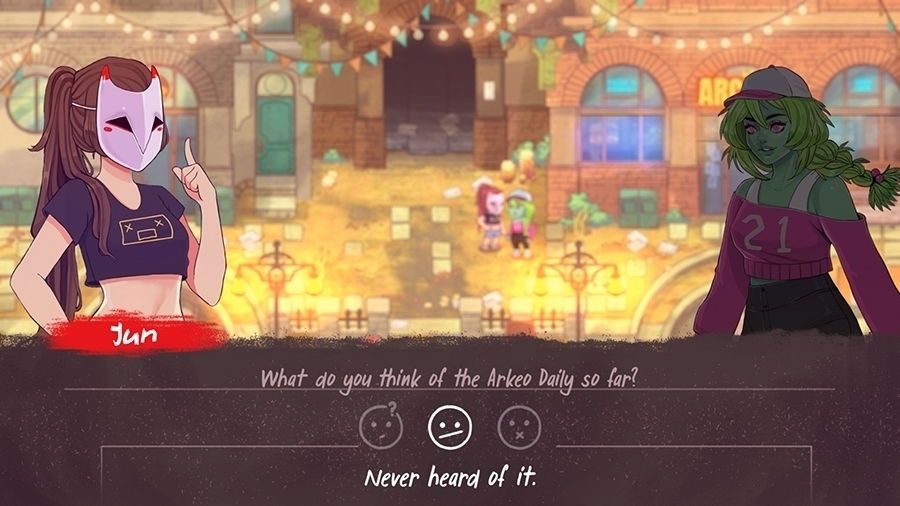
On my PC run, I was the nicest girl I could possibly be with Jun. I always picked the most respectful responses and tried my best to be friends with everyone. On the Switch, I was the total opposite. I acted like this trip was a complete waste of time and I really let one of them have it when a certain story plot came up in the fourth act. None of my choices mattered in the end because the same result was had.
What was different; however, were certain scenarios. Depending on who you keep taking with you into the shrines, or who you answer most favorably to, it will affect one certain scene in the fourth act along with a special message from that friend at the end of the game.
For example, on my PC run through the game, I paid the most attention to Rainy and, in the end, he ran up and gave me a special message. I completely ignored him on the Switch and since I was a complete and total jackhole, which aligns with Horace’s personality, he ran up to give me a special message. I assume that this is true for all characters so it might be worth running through the game multiple times to see each and every special message at the final scene.
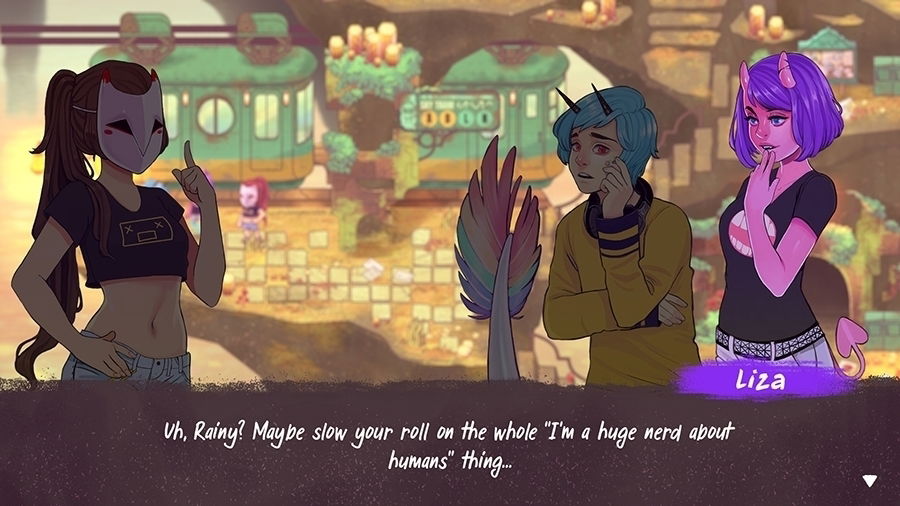
Game Systems – Leveling and Questing
I covered the Puzzle and Visual Novel elements so let’s go ahead and talk about the RPG elements in the game. This is, in my opinion, where the game really lacks content.
Outside of the academy, there’s nowhere to go. You are confined to this one area for the entirety of the game (save for when you go to the shrines). The game is broken up into 5 Acts: Prologue and Acts 1-4. You have the option to just go to the shrine in that act and complete the game in under three hours if you desire. The other option is before heading to the next shrine, to go around and talk to people and accept their side quests.
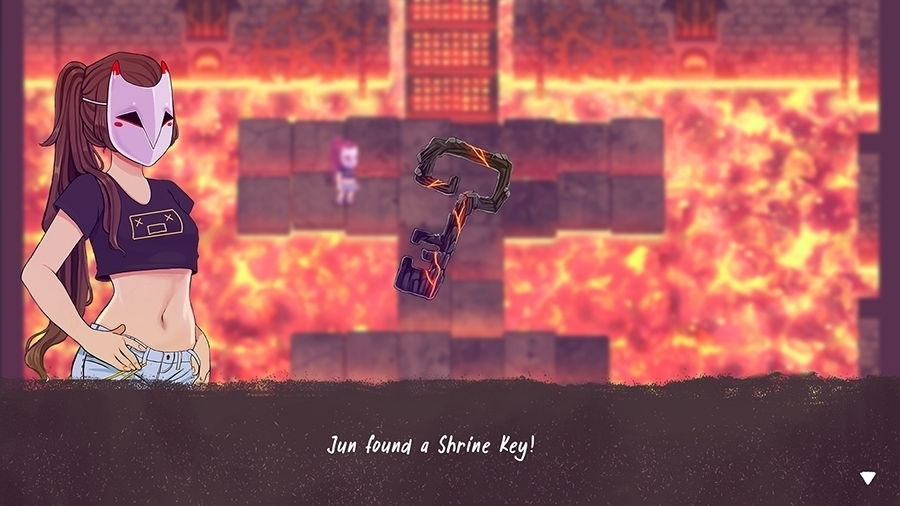
There’s only a handful of side quests and since all of them involve the academy grounds, they are really short and easy to complete. Some are as simple as delivering a love letter, or finding someone’s hat. Some of the characters help build on the main story and you do get to experience each of their own personalities and viewpoints on what’s happening. Interacting with them does add depth to the game but it doesn’t necessarily mean it is required. On my Switch playthrough, I ignored all of the side quests and still got the full gist of the story. On my PC playthrough, I complete all of the side quests and it added about an extra 90 minutes to the game.

Leveling in this game is done automatically. There is nothing to farm, no experience to grind out. You simply are granted a new level once you begin the shrine in the next act. Your attacks do deal a little extra damage but you are still left with the same 250 HP for life.
That’s about it for the RPG elements of the game. The side quests were engaging even though they were short but the leveling system didn’t feel like it was needed at all. I guess if you want to get a sense of progression then that would be a good indicator of it but I felt like they could have just kept you at one level and you would have been fine throughout the game.
Art, Animation, & Sound
When it comes to art, The World Next Door really shines! The in-game artwork for the shrines, academy, and any other background was absolutely superb. I loved the mystical feeling of the game. The art style really drove home the fact that you were in another world but not to the point where it felt completely foreign. Sure, the inhabitant of Emrys were all unique-looking in their own right but their academy grounds looked like any other that you would find here on Earth. The shrines themselves felt like typical dungeons that you would find in any fantasy setting so that helped with the otherworldly aspect as well.
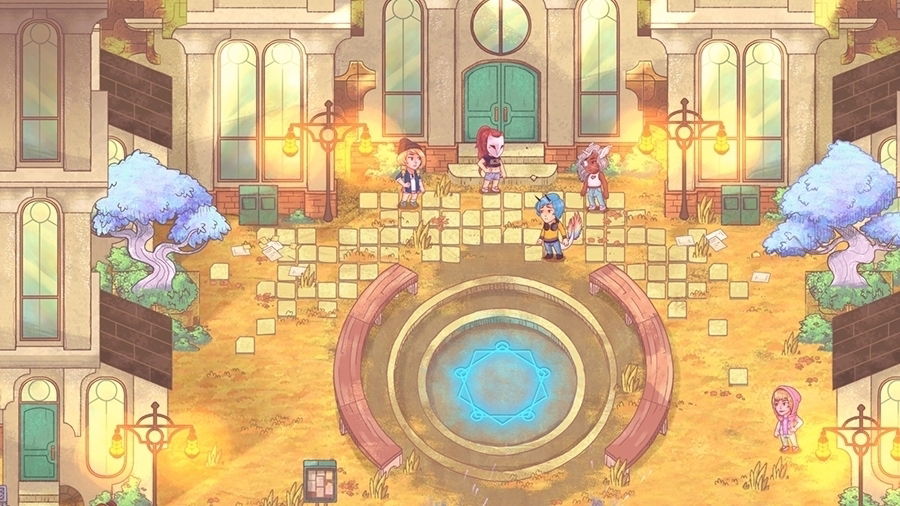
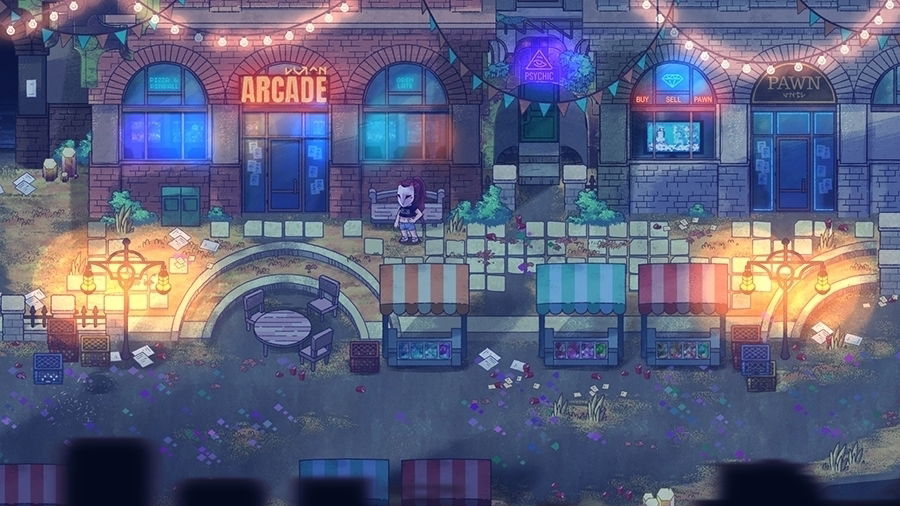
The only thing I didn’t really care for all that much was the character designs. The designs themselves looked a little amateurish and their in-game models didn’t really look all that great either. I felt that they could have done a better job with those designs as they really looked out of place versus the rest of the artwork.
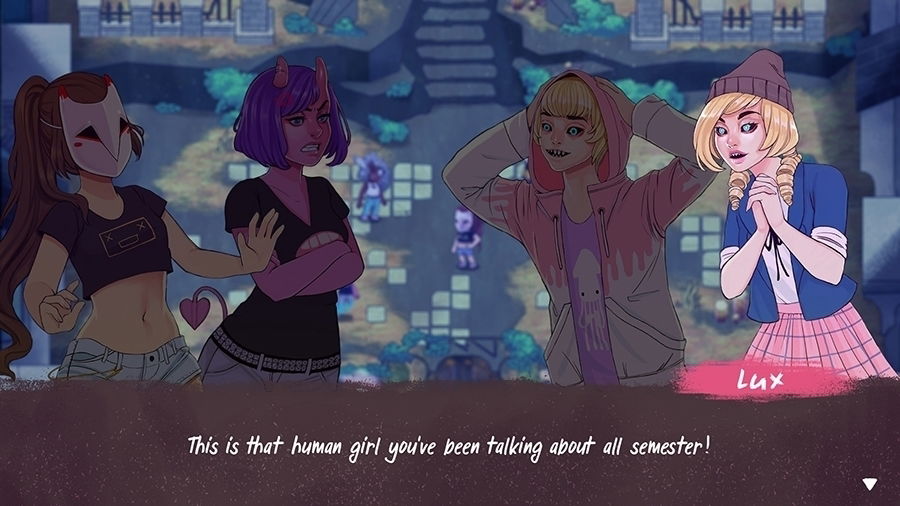
The animations were a bit on the odd side as well. Overworld avatars could only face left or right so when you’re moving around the world in either a left or right fashion, it looked fine but if you move up or down, it looks like your character is running to the left or right but isn’t really going in that direction. It would have been nice to see two more sprites for Jun to show her running up and down just to help with the immersion a bit.
One thing that stood out was the music. While the battle themes weren’t all that intense and didn’t really draw you into the action, the background music during the game was pretty light, upbeat, and catchy. Great usage of the piano gave the game that typical visual novel feel to it. The right songs played at the right moments to enhance some of the story aspects.
Overall Thoughts
Despite some of the flaws with the art and animation, the game is pretty fun the first time you play through it. Learning about the rune combat system was fun and it definitely kept you on your toes. One thing that was a bit of the bother was that normal enemies in force were a tougher challenge than the bosses in the shrine. Especially on my second playthrough on the Switch. I annihilated the final boss before I even realized it. In both playthroughs, I never died to any of the bosses but I did die on a couple of encounters with multiple enemies. I think there is a bit of a difficulty imbalance there that could have been tweaked a bit better. Dying doesn’t have much of a punishment, either. You always start at a checkpoint in the shrine and anything you killed before you died stays dead. Also, any healing wells that you used are also reset to use again.

Speaking of both versions, I played through both the PC and Switch versions to see if I could spot any differences and I have to say that, unfortunately, The World Next Door runs much better on Switch than it does on PC, which surprised me. On PC, there were some horrid input lag issues when playing on Steam with an Xbox One X controller. I was literally standing on a set of runes mashing the attack button and it wouldn’t cast the spell. Finally, after about ten seconds, the spell went off. Grabbing and placing runes on PC was hit or miss. Sometimes it wouldn’t grab a rune or sometimes the spell refused to become active once the rune was placed for a few seconds. This made some clutch situations impossible to pull off, especially against the enemies that steal your runes and use them against you. Often times I had my runes stolen because they wouldn’t cast when I commanded them to. There was also lag when moving between areas at the academy. It would take several button presses to get it to accept the command.
The Switch did not have that problem at all. Every rune I moved and placed went smoothly. Spells cast without fail and it was a much smoother overall experience.
In both the PC and Switch version, there’s a common glitch with bosses just standing there and doing nothing. On the PC version, it happened with the final boss in Act 4, on the Switch, the second boss in Act 2. At one point, the boss just stood there and did nothing, allowing me to just attack it freely until it fell over dead. I appreciate them just accepting their fate at my God-tier gaming skills but perhaps a patch could be used to fix that issue.
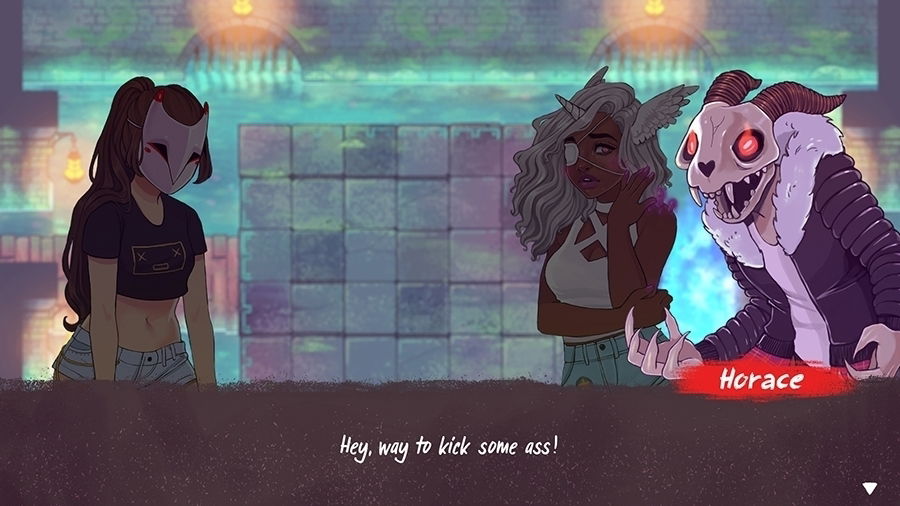
The length of The World Next Door was also surprisingly short. You can go back and visit shrines on some of the side quests but you are limited to whatever side quest you’re doing, which usually involves going in behind a locked door that you couldn’t access your first time through. The lack of open world exploration really made the game feel confined and claustrophobic. The academy only had four or fives screens to it and outside of talking to NPCs, there was very little to interact with on the academy grounds. The formula was the same throughout all of the chapters which were Listen to Story -> Go to Shrine or Talk to People then Go to Shrine -> Wrap Up Story -> Next Act and Repeat.
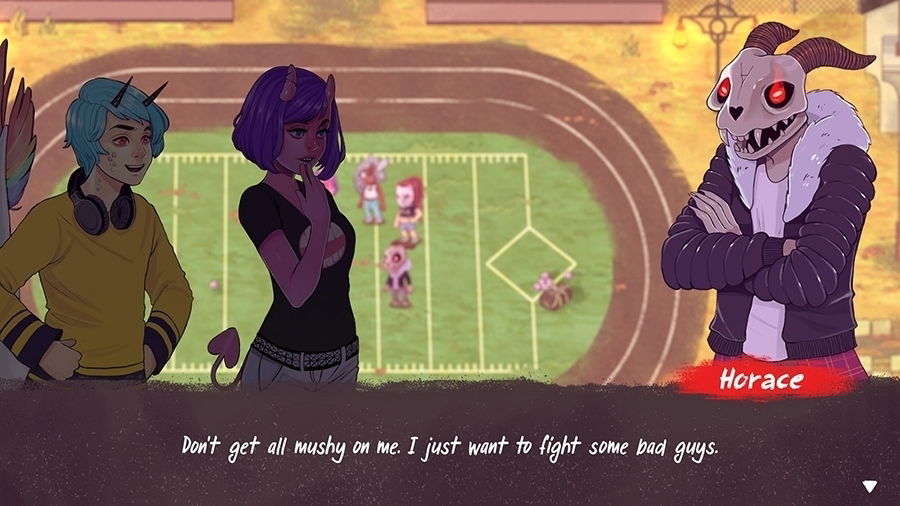
There were some dramatic moments in The World Next Door’s story but a lot of them were predictable. They also didn’t even resolve some of the conflicts in the story. I’m still wondering just what happened to Persimmon since that was never truly resolved! It almost seems like the story was rushed in that aspect.
Overall, for a first game, it’s not bad. There are definitely some improvements that could be made but if you have a couple of hours to kill, it’s a fun game with a decent story that will draw you in. The only downside is that it doesn’t offer up enough to replay the game over and over again unless you are a die-hard completionist and want to see all the special messages at the end of the game. Still, for $15, you can’t really go wrong with this title. I still think it’s $15 well spent for a couple of hours of entertainment!
I mean, what are you going to do with $15? Go to the store and buy some candy?

Review Disclosure Statement: The World Next Door was provided to us by VIZ Media for review purposes. For more information on how we review video games and other media/technology, please go review our Review Guideline/Scoring Policy for more info.
Buy on Steam: https://store.steampowered.com/app/755470/The_World_Next_Door/
Nintendo Switch: https://www.nintendo.com/games/detail/the-world-next-door-switch#game-info
Official Website: https://www.viz.com/the-world-next-door
The World Next Door
Summary
The World Next Door combines elements of a Puzzle Game, Visual Novel, and an RPG to tell the story of a girl named Jun trapped on the world of Emrys and needing to get home before she dies. Go through four acts with great puzzle-solving combat to discover the way to get Jun home!
Pros
- Fast-Paced Combat System
- Great background art
- Immersive Soundtrack
- Predictable, yet, fun story
Cons
- Game felt a little too short
- Some character designs really looked amateurish
- Choices had very extremely minute effects on the game
- Input lag on PC version (Switch version was fine)
- RPG elements seemed unnecessary


